The most successful political party in American politics during the 1830s was the Democratic party under the leadership of Andrew Jackson. His split from the Democratic-Republicans in the wake of the “corrupt bargain” caused a schism in the political block that had seamlessly controlled the federal government since the “Revolution of 1800”. As custom dictated, Jackson did not run for a third term, but he was able to effectively anoint a successor by supporting the electoral efforts of his second Vice President, Martin Van Buren; a feat that would not be repeated for over 150 years when George H. W. Bush was elected in 1988. However, the election of Van Buren was not smooth, and the Whig opposition was very nearly able to send the election to Congress. Eventually, it was the vice-presidential race that made history.
Firstly, an overview of presidential selection is in order. Bits and pieces of the process are somewhat scattered about the U.S. Constitution; in part, because it is necessary to reference provisions outside of the dedicated section of Article II which describes the process and because the Twelfth Amendment altered the process in the wake of the Presidential Election of 1800. Additionally, though this does not become particularly relevant in this instance, the Twentieth Amendment also adds a few provisions to the process.
Presidential selection was a hotly contested topic during the Federal Convention of 1787, and the Framers floated several different methods for picking the person, or persons, who would wield the executive power of the national government. The process they eventually adopted provided for an indirect form of selection such that the president would be elected by electors appointed by the state legislatures for that purpose. Over time the appointment of electors has, by statue, been dependent upon the popular vote within each state. By the election of 1836, all of the states except South Carolina had adopted a method of appointment that was dependent upon a popular vote of the state electorate.
The “electoral college” mode of selection, as it has come to be known, was thought to provide a degree of separation between the executive and legislative branches of government, while also guarding against the excesses of popular opinion (see Madison’s comments here). The number of electors would be determined by how many house members and senators each state would be entitled to have in congress; a minimum of three (see Article I, Sections 2 & 3 and Section 2 of the Fourteenth Amendment). These appointed electors would meet and cast a ballot for a person to be the president and a separate ballot (after the Twelfth Amendment) for a person to be the vice-president; at least one of whom would need to inhabit a state other than the elector.
The count of these electoral ballots would be finalized in a joint session of congress, and for both the presidential and vice-presidential ballots, an absolute majority would be necessary. In the event that the presidential ballot was inconclusive, the House of Representatives would select, from among the three top candidates, the next president by voting as state delegations; similarly, if the vice-presidential ballot was inconclusive, the Senate would select, from among the two top candidates, the next vice-president by a majority of the whole chamber.
On only a few instances have the contingency scenarios come to pass. One such occasion was the Election of 1824, which concluded with the House of Representatives selecting John Q. Adams as president over Andrew Jackson, who had received a plurality of the votes cast by electors. For the Jacksonians, this resulted from a “corrupt bargain” between various factions within the Democratic-Republican party and beyond.
The Election of 1836, however, is quite unique because it was the only time that a vice president has been selected by the senate. Although presidential campaigns had already evolved into largely singular campaign efforts such that presidential candidates and vice-presidential candidates ran together on a single ticket, electors still cast separate ballots in accordance with the process dictated by the Constitution. For most of American presidential election history, this has meant that the vice-presidential candidate associated with the winning presidential candidate has been elected to the office of the vice-president. Yet, in the Election of 1836, this was not the case.
Richard Mentor Johnson was the running mate of Van Buren, but he was only narrowly nominated by the Democratic convention and brought with him substantial baggage. When the electors met to cast their ballots, the electors from Virginia cast their votes in favor of Van Buren for president, but did not vote in favor of Johnson for vice-president. Electors, such as these, who buck their pledge and vote for a different presidential or vice-presidential candidate are called “faithless electors”, and there is a long tradition – though perhaps a fading tradition – of electors behaving in this manner throughout American electoral history. As such, when the votes were tallied by congress, Van Buren garnered the necessary majority while Johnson was a single vote shy.
In accordance with the election process of Article II, the Senate became responsible for selecting the vice president. Johnson eventually received a majority of senate votes, and served a full term as vice-president under Van Buren. Van Buren, however, lost the election of 1840 to William Henry Harrison, an election which has remained famous for the catchy campaign slogan “Tippecanoe and Tyler Too”. Johnson, still seen as an unattractive vice-presidential running mate, was not nominated by the Democratic Convention leading up to the election; instead, Van Burne had no official running mate during the election as none of those seeking the position could garner sufficient support in the Convention.
In general, I find the topic of “faithless electors” fascinating, and I’m sure I will discuss them in a later essay.





